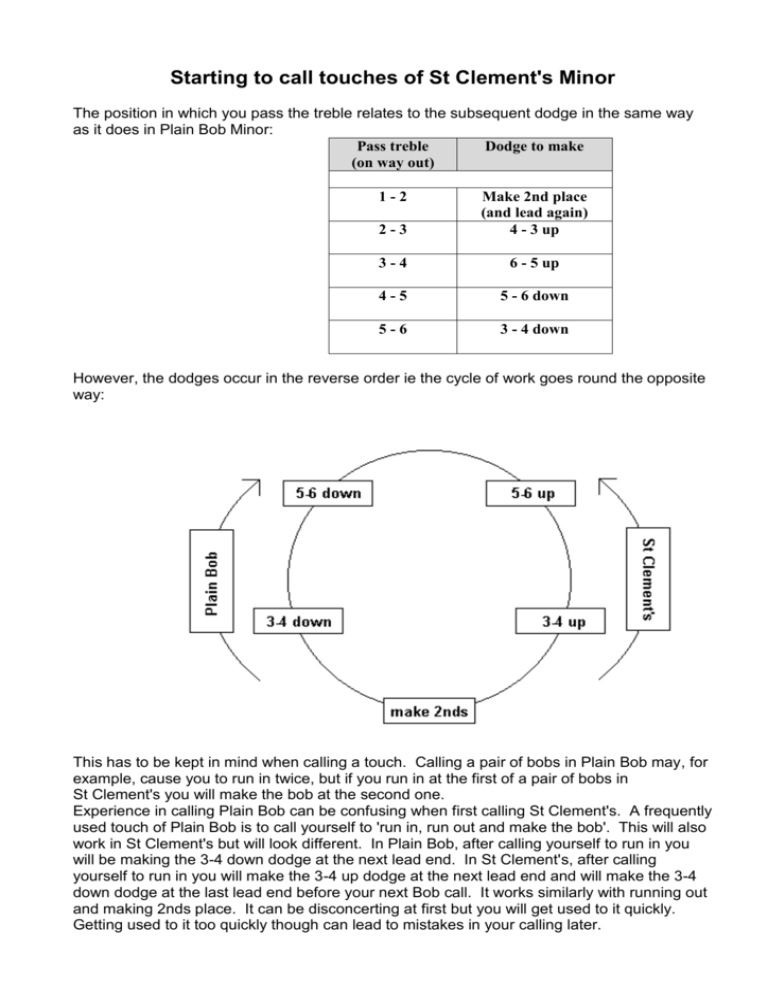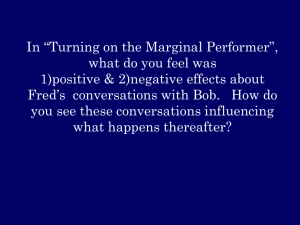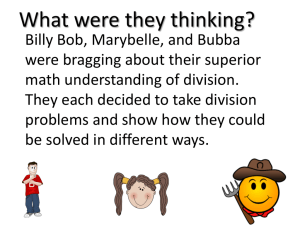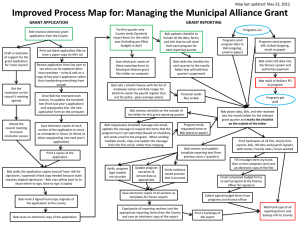Starting to call touches of St Clement`s
advertisement

Starting to call touches of St Clement's Minor The position in which you pass the treble relates to the subsequent dodge in the same way as it does in Plain Bob Minor: Pass treble Dodge to make (on way out) 1-2 2-3 Make 2nd place (and lead again) 4 - 3 up 3-4 6 - 5 up 4-5 5 - 6 down 5-6 3 - 4 down However, the dodges occur in the reverse order ie the cycle of work goes round the opposite way: This has to be kept in mind when calling a touch. Calling a pair of bobs in Plain Bob may, for example, cause you to run in twice, but if you run in at the first of a pair of bobs in St Clement's you will make the bob at the second one. Experience in calling Plain Bob can be confusing when first calling St Clement's. A frequently used touch of Plain Bob is to call yourself to 'run in, run out and make the bob'. This will also work in St Clement's but will look different. In Plain Bob, after calling yourself to run in you will be making the 3-4 down dodge at the next lead end. In St Clement's, after calling yourself to run in you will make the 3-4 up dodge at the next lead end and will make the 3-4 down dodge at the last lead end before your next Bob call. It works similarly with running out and making 2nds place. It can be disconcerting at first but you will get used to it quickly. Getting used to it too quickly though can lead to mistakes in your calling later. So here are some short touches to try. Touches 1 and 2 are very short but can be doubled in length with a pair of singles. Touch 3 is a bob course (a bob is called at every lead end). If you call by the work of the tenor then touch 4 should be the easiest to start with as the tenor is the observation bell. If you call by the leads, there is a repeating pattern in touches 4 and 9 and they also come round at the final bob. Although touches 9 to 12 are longer than two courses (120 changes) I've included them here because they are so useful. Touch 9 is particularly useful as bell 4 is unaffected until the last call that brings the touch round. In touch 10, bell 2 is unaffected until it makes the bob at the last call and goes into the front work for the last lead. Touches 11 and 12 could not be much simpler to call from the tenor! Touch number Number of changes Calling by lead If called from the tenor 1 2 3 4 5 6 7 8 9 10 11 12 48 48 60 120 120 120 120 120 144 144 144 144 B-B-B-B BBBBB - - - BB - - - BB - - BB - - - BB - BB - - - BB - BB - - - BB - - BBB - - BBB - ---B---B---B --B---B---B-B---B---B-B---B---B--- IW OH I4OWH WHWH 4OOW OW4O I4HI I4OI4O W4H 4HW OOO III * Key: W=Wrong (5-6 up) 4=4ths / Make the Bob O=Run Out I=Run In H=Home (5-6 down) * The tenor (bell 6) is the observation bell (unaffected by the calls) in this touch. If you have previously called 'In, Out and Make it' for Plain Bob Minor, touch 8 should look familiar. Notice, though, that it is a two-part calling and that the calls go round in the opposite direction. The bells are transposed in this way for the three types of lead: Next, here are some short touches using just singles: Touch Number of Calling number changes by lead 1 2 3 4 5 6 7 8 9 10 11 12 72 96 96 108 108 108 120 120 120 120 120 120 SSSSSS -S-S-S-S S-S-S-S- SS - SS - SS S - SS - SS - S SS - SS - SS ----S----S ---S----S--S----S--S----S--S----S---- - - SS - - - SS If called from the tenor 3WH3WH 2W3H 3H2W 2442WH 3H3H3H 3W3W3W HH WW 43 22 34 WHWH # # # * * * * Key: W=Wrong (5-6 up) 4=4ths 3=Make 3rds 2=Make 2nds (unaffected) H=Home (5-6 down) * The tenor (bell 6) is the observation bell in this touch # The tenor is not involved with the front work in these touches. There are many more than these and if you know a short touch of Plain Bob that use singles only it will also work with St Clement's, though the effect of the calls will be somewhat different. To show how they work, I have written out some mixed short touches of St Clement's: This is a handy little touch of just 72 changes: S S B B 1 1 1 1 1 1 1 2 4 2 5 3 4 2 3 6 4 2 6 5 3 4 2 5 3 5 3 4 5 3 6 4 2 6 5 6 5 3 6 4 2 6 Bob touch number 1 can be doubled from 48 to 96 changes by the use of two singles: 1 2 3 4 5 6 B 1 6 4 2 3 5 1 2 6 5 4 3 S 1 5 3 2 6 4 1 2 5 4 3 6 B 1 6 4 2 5 3 1 2 6 3 4 5 S 1 3 5 2 6 4 1 2 3 4 5 6 And this is another touch of only 96 changes: S B S B S B S B 1 1 1 1 1 1 1 1 1 2 4 5 4 6 4 3 4 2 3 6 2 3 5 2 6 5 3 4 2 4 5 4 6 4 3 4 5 3 6 2 3 5 2 6 5 6 5 3 6 2 3 5 2 6 These two-part callings are of 144 changes each: B B S B B S 1 1 1 1 1 1 1 1 1 1 1 1 1 2 6 5 6 5 4 2 6 5 6 5 3 2 3 4 2 3 6 5 4 3 2 4 6 5 3 4 2 6 5 4 2 3 2 6 5 3 2 4 5 3 4 2 3 6 5 4 3 2 4 6 5 6 5 3 4 2 3 6 5 4 3 2 4 6 B S B B B S B B 1 1 1 1 1 1 1 1 1 1 1 1 1 2 6 2 5 3 6 2 4 2 5 3 4 2 3 4 6 2 4 5 3 6 4 2 6 5 3 4 2 5 3 5 3 6 2 5 3 5 3 4 5 3 4 6 2 4 5 3 6 4 2 6 5 6 5 3 4 6 2 4 5 3 6 4 2 6







